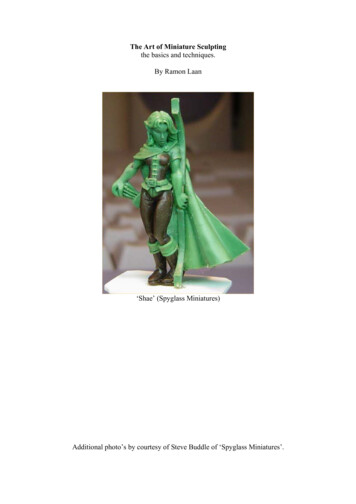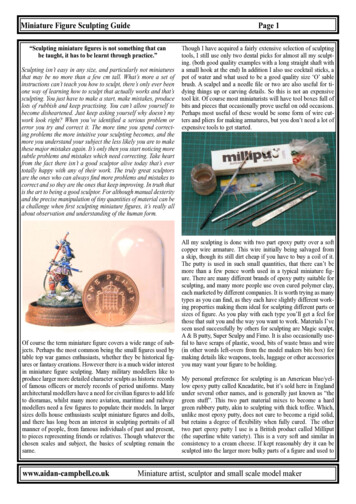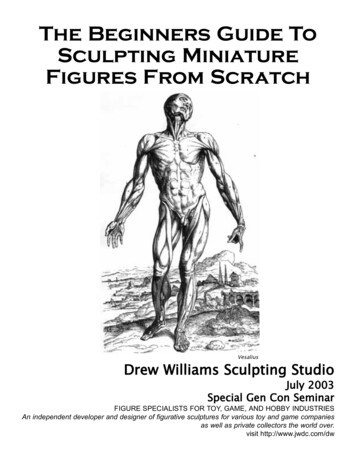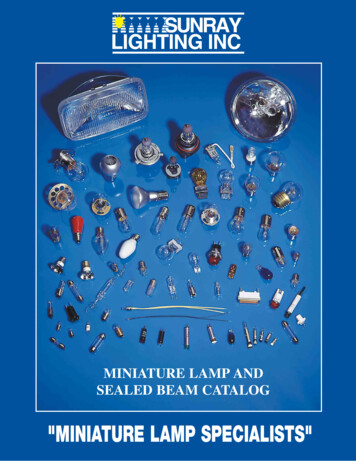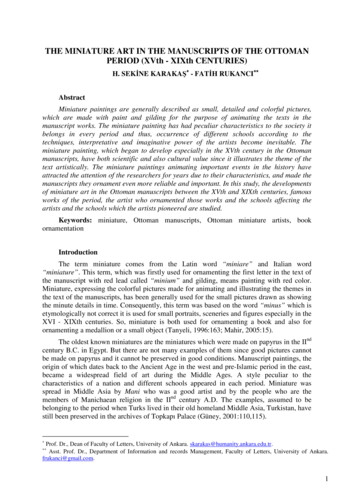
Transcription
THE MINIATURE ART IN THE MANUSCRIPTS OF THE OTTOMANPERIOD (XVth - XIXth CENTURIES)H. SEKĐNE KARAKAŞ - FATĐH RUKANCI AbstractMiniature paintings are generally described as small, detailed and colorful pictures,which are made with paint and gilding for the purpose of animating the texts in themanuscript works. The miniature painting has had peculiar characteristics to the society itbelongs in every period and thus, occurrence of different schools according to thetechniques, interpretative and imaginative power of the artists become inevitable. Theminiature painting, which began to develop especially in the XVth century in the Ottomanmanuscripts, have both scientific and also cultural value since it illustrates the theme of thetext artistically. The miniature paintings animating important events in the history haveattracted the attention of the researchers for years due to their characteristics, and made themanuscripts they ornament even more reliable and important. In this study, the developmentsof miniature art in the Ottoman manuscripts between the XVth and XIXth centuries, famousworks of the period, the artist who ornamented those works and the schools affecting theartists and the schools which the artists pioneered are studied.Keywords: miniature, Ottoman manuscripts, Ottoman miniature artists, bookornamentationIntroductionThe term miniature comes from the Latin word “miniare” and Italian word“miniature”. This term, which was firstly used for ornamenting the first letter in the text ofthe manuscript with red lead called “minium” and gilding, means painting with red color.Miniature, expressing the colorful pictures made for animating and illustrating the themes inthe text of the manuscripts, has been generally used for the small pictures drawn as showingthe minute details in time. Consequently, this term was based on the word “minus” which isetymologically not correct it is used for small portraits, sceneries and figures especially in theXVI - XIXth centuries. So, miniature is both used for ornamenting a book and also forornamenting a medallion or a small object (Tanyeli, 1996:163; Mahir, 2005:15).The oldest known miniatures are the miniatures which were made on papyrus in the IIndcentury B.C. in Egypt. But there are not many examples of them since good pictures cannotbe made on papyrus and it cannot be preserved in good conditions. Manuscript paintings, theorigin of which dates back to the Ancient Age in the west and pre-Islamic period in the east,became a widespread field of art during the Middle Ages. A style peculiar to thecharacteristics of a nation and different schools appeared in each period. Miniature wasspread in Middle Asia by Mani who was a good artist and by the people who are themembers of Manichaean religion in the IInd century A.D. The examples, assumed to bebelonging to the period when Turks lived in their old homeland Middle Asia, Turkistan, havestill been preserved in the archives of Topkapı Palace (Güney, 2001:110,115). Prof. Dr., Dean of Faculty of Letters, University of Ankara. skarakas@humanity.ankara.edu.tr.Asst. Prof. Dr., Department of Information and records Management, Faculty of Letters, University of Ankara.frukanci@gmail.com. 1
This art is transferred to the Persian from the Chinese and Turks and from them toEurope. Turks and Persians named this painting style as “nakış” (embroidery), “tasvir”(picture) meaning colorful picture and named the person who makes them as “nakkaş”(designer painter) And “musavvir”. However, since every kind of embroidery made withcolorful threads is also called nakış, The term miniature is used in order to distinguish theseterms. The duty of a designer painter to illustrate what is told either literary, scientific orhistorical in all details being faithful to the text. On the other hand, miniaturists of Islam haveto obey some rules the abstract world view of Islam doctrine provides in all fields. Miniatureis a form of expression with figures. However, when illustrating the events in the textcontrary to West painting tradition which is based on light-shadow, perspective and colorvalues, designer painter can abstract the living things and objects and he can transform theminto a very different decorative element. Buildings and trees can be seen leaning to one side,it can be possible to paint the horses blue, mounts lilac, sky gilding; the human figure, whichtransformed into a two dimensional form as in shadow play, may not be proportional to theobjects around it. Consequently, the miniature masters, who painted elements from nature asif they are abstract embroidery elements, searched for a reality which is independent from thenature and pictured whatever thought and felt. They contrary to Western masters who are inthe effort of picturing the real nature at their best for hundreds of years (Renda, 1997:1262).The themes of miniatures are generally historical events such as ascending the throne,ceremonies, hunting and war. Furthermore, the miniatures ornamenting the religious booksand scientific books such as medicine, zoology, botany, astrology and etc. may also befrequently found. There was a trend on making a general scheme in understanding ofminiature painting. Although the faces of particular people (like sultans) were depicted,facial expressions were not given. A beautiful woman is generally painted with thineyebrows, a little mouth, eyes like almond and long hairs. The necessity of drawing thefigures smaller if they are in the background is not emphasized and attracting attention to onimportant figure is provided by drawing it bigger. Generally various parts of the sameminiature can be drawn from different point of views. The important thing is to give eachelement in a composition carefully. In contrast to all of these linear characteristics which givea superficial appearance to miniature, the colors are always bright and lively. In miniature,scenes, people and other details are treated in the smallest details. The artist thinks ofaddressing to the thoughts more than the eyes by painting colors, shapes and designs of thedresses and garments as appropriate to the original. The things which are thought andimagined are drawn more than the things which are seen. Sultan and the statesmen aredependent on a hierarchy in picture. Since there is no depth in miniature, neither objects norpersons are shown in the background. When there is a necessity for showing the ones inbackground and foreground, the ones in foreground are placed in lower part and the ones inbackgrounds are placed in upper part of the picture.In miniature painting, the colors were applied as one on the top of the other and earthpaints, which had been thinned by water, were used in order to prevent the risk of mixing. Inthe XIVth and XVIIth centuries, fresh egg yolk was added to these paints in order to makethem stable. The paints prepared with this method were not used second time and a new paintwas prepared for each usage. For this reason, glue melted in water was added instead of eggyolk and a drop of molasses or two drops of grape juice were added to this glue in time.Therefore, the paints could be stirred in any time even if they get dry. The brushes and quillpen in various thinness which are suitable for miniature painting were made from pigeonwings, and the feather tips of them are made from the feather on the napes of the three-monthold cats, so thin shapes and lines could be drawn. After white lead mixed with Arabian gluewas spread on the paper on which miniature painting would be made, pictures would be2
made with quill pen and the paper would be filled with colors. A thin golden layer wassometimes spread on white lead in order to give transparency to the colors. Tulle painting inminiature necessitates a special technique. After the main design was painted, it was grindedfinely with mühre. Then white paint diluted much with water was dropped on the top, and itwas spread at once by drawing down with brush. After drying, hatching was made with paintand it was given a shape. The theme, which would be treated in the miniature, was drawn onthe paper with tile red paint and sepia ink by means of very thin brushes. In painting process,first gold was spread and then other colors were spread (Tahirzade, 1974:199; Mahir,2005:15-16).In the works made by Turks in Islamic period, although Islam forbids the picture,historical and scientific books were ornamented with miniatures thanks to tolerance shown tothe pictures which have not religious characteristics. At the end of the XIIIth and at thebeginning of the XIVth century, Uighur artists opened an era in miniature art in thedomination of Ilkhans. They created masterpieces in miniature in centers such as Meraga andTabriz.Early Period (XVth Century)Although the early examples of Ottoman miniature art originated from Seljuk paintingstyle, it was affected by Timurid and Turkmen miniature styles (Mahir, 2005:39). Theearliest Ottoman manuscripts with miniatures are an illustrated copy of “Đskendername” bythe poet Ahmedi, which was copied in Amasya in 1416. Đskendername completed, byAhmedi in 1390, is an important work in which stories about Đskender of Macedonia(Alexander) are told. This work also includes the Islamic and Ottoman histories and the partsof Mevlit (poem by Süleyman Çelebi celebrating the birth of the Prophet Muhammad)(Bağcı, 1994:112). Ahmedi’s “Đskendername” was written in the XVth century haveimportance as being the first illustrated history of the Ottomans. Moreover, the painstakingminiatures of the Venice copy including the histories of the sultans reigned from ErtuğrulGhazi to Süleyman Çelebi have become examples for muralists illustrating the historicalmanuscripts in later periods (Çağman, 1982:932).As a result of researches and evaluations of styles, it is understood that the early periodOttoman miniature was shaped within small literary manuscripts prepared in Edirne between1455-1480; and there are contribution of the artists of Shiraz who transferred Timurid andTurkmen painting tradition to the Ottoman culture. Another work representing the earlyperiod of the Ottoman miniature art is the manuscript called “Dilsuzname” of Bedi’eddinMinuçihr el-Taciri el Tebrizi, prepared in Edirne between 1455-1456. Five miniatures in thissmall work are productions of Edirne Sarayı Nakkaşhanesi (Imperial Studio of EdirnePalace) which lost its importance after the conquest of Đstanbul. While these picturesattracting attention with their simple compositions and weak techniques reflecting the effectsof Shiraz of Timurid miniature style, the characteristics peculiar to Ottoman are seen in thehard lines which shapes the figures, huge plan motifs drawn in human dimension and womancaptions peculiar to Turks. From this point of view, the miniatures of Dilsuzname areimportant since they are one of the first examples of the early period and reflect particularcharacteristics of Ottoman book painting (Mahir, 2005:43-44; Çağman, 1946:335-336).Another illustrated manuscript, which dates back to the years between 1460-1480, is“Küllüyat-ı Katibi” including Şemseddin Muhammed bin Abdullah Nişaburi, whose penname was Katibi. The miniatures of this work prepared in small dimension as in the previouswork were made by two different designer painters and one of them resembles the miniaturesof Dilsuzname which was written in Edirne. It is necessary to state that treat of natural3
elements,especiallycypresses and huge flowerbouquets lined up on thehorizon, would become thedefinite characteristics oflater Ottoman miniature art(Çağman, 1946:346).AccordingtoAşıkpaşazade, the historianof the period of Mehmed I;Vizier Hacı Đvaz Pasha giveimportance and support theartists and invited the artistsof other countries to Bursa.Since the Ottomans weremore conservative thanFigure-1 Eyüp and Salman come before the SultanSeljuks, they give moreKülliyat-ı Katibi - 1460importance to illumination,Library of Topkapı Palace Museumcalligraphyand(Call no. R. 989 pp. 229b-230a)ornamenting with embroidery, they avoided drawing human faces; therefore the artistsgathered in Bursa made mostly architectural ornamentations (Güney, 2001:112). In theOttoman style by using quite plain and two-dimension expression without having lightshadow effects and perspective, documentary qualities became the most important aspect.Therefore, its documentary quality gives miniature a characteristic of being a historicalsource.The development of painting and miniature in the Ottoman began after the Conquest ofĐstanbul. Many miniature works, belonging between the period of Fatih Sultan Mehmed (theConqueror) and the XIXth century, reached today. Many works with miniature made in theperiod of Fatih shows the effects of Turkmen miniatures. These works reflect somecharacteristics of the period such as dressing, musical instruments and entertainment life.Medical book Cerrahiye-i Hakaniye, prepared in Amasya in 1465, presents provincestyle. The general aspects of these miniatures are that they are expressing various operationsin a clear and plain way with a linear style. There are two copies of this work, which werecopied in 1465-1466, and prepared by a doctor named Şerafeddin Sabuncuoğlu (Güreşsever,1979:772-775).As the Ottoman Empire was getting stronger as well, the interest and support of thepalace administration to art and artists got stronger, and as in the other branches of the art,the duty of protection of book art and artists was undertaken by sultans, grand viziers,princes, viziers, sultanas and higher level statesmen such as governors of provinces andheads of financial departments (Tanındı, 1993:409).It is known that Fatih gave importance to Italian artists and had them brought to thepalace. In this frame, Turkish artists were educated and some of them were sent to Italy foreducation. The most famous one is the student of Pavli Sinan Bey who is known for theminiature portrait of Fatih. Fatih Sultan Mehmed was pictured sitting cross-legged in aninformal way. In this portrait, reflecting the sensitive personality of Fatih successfully, thesultan was pictured as looking thoughtful while smelling the rose in his hand. Both lightshading in his face and also the treat of his caftan’s collar show that how the styles of Westand East reached a new synthesis in the hands of Turkish artists. This portrait, in which4
Timurid miniatures and the realist style of Italian painting art were tried to be united, hasimportance as an original work starting the tradition of portraiting sultans in the Ottomanminiature art (Raby, 200:82; Atıl, 1973:103-120).Development Period and the Birth of the Classical Style (XVIth and XVIIth Centuries)In the period of Bayezid II (1481-1512), the son of Fatih Sultan Mehmed, the Ottomanminiature painting showed development suitingthe characteristic occurred under the protectionof contemporary Islam rulers. In this period, theillustrated copies of literary manuscripts such as“Kelile ve Dimne” (Hüseyin Çelebi), “Hüsrevü Şirin” (Şeyhi) and “Yusuf-u Züleyha” wereprepared in Nakkaşhane of Đstanbul (Mahir,2005:47-48). The eight miniatures added to“Hamse-i Hüsrev Dehlevi” copy, which wasprepared in Herat in 1498 but brought to theOttoman palace without being completed;belong to this period (Tanındı, 1977:14). Intheseminiatures,athree-dimensionalappearance was tried to be given witharchitectural drawings, volume was given withshady painting in natural elements, and eyes ofthe spectators were drawn into the depths withdetails of scenery and interior details. All thesetrials present the effect of the European artistsin the Ottoman Imperial Studio. Moreover, theeffects of XVth century Shiraz style are tracedin some figures and natural elements.Consequently, it can be said that the miniatureart in the period of Bayezid II was shaped withthe common work of West and East originatedFigure -2 Behramgür in White Kioskartists (Atasoy ve Çağman, 1947:19-20).Hamse-i Hüsrev Dehlevi-1498Another illustrated manuscript in the period ofLibrary of Topkapı Palace Museum(Call no. H. 799 p.196a)Bayezid II is Uzun Firdevsi of Bursa’s“Süleymanname” which deals with the miraculous life of Süleyman, the ruler and wiseprophet. One of the miniatures, placed on the opposite pages of the book includingencyclopedic information, depicts the Prophet Süleyman sitting in a house covered by adome and the other one depicts Belkıs sitting in a similar house (Mahir, 2005: 48-49). In bothof them, the people at their sides and cosmographic descriptions were shown in horizontallines arranged one under the other. Some researchers relate this unique design, to thetradition of fresco (Atasay ve Çağman, 1974:20). “Şehname-i Melik-i Ümmi”, written byMelik-i Ümmi and copied and illustrated by Muhammed bin Abdullah Nakkaş later, is ahistorical book written in verse and it deals with the events day covering the years 1484-1485of Bayezid II reign (Tanındı, 1991:143). It is possible to consider this work as the first stepfor institutionalization of Şeyhname which would gain a formal characteristic in the period ofKanuni Sultan Süleyman. This institution would have been the main source of illustratedOttoman history writing until the beginning of the XVIIth century.5
Figure-3 Hz. SüleymanMantık’ut-Tayr 1515Library of Topkapı Palace Museum(Call no. EH1512 p.1b)Selim I invited a group of artists fromTabriz and Horasan to Đstanbul fromNakkaşhane of Tabriz, a place that gainedsuperiority over Islamic World after IranWars. When the western artists representingdifferent traditions started to produce workstogether, a decorative style, which wouldhave gone on until the middle of the XVIthcentury, occurred. Therefore, the effects ofMamluk and Safevid Tabriz style, besideShiraz style, reflected on the details andcomposition arrangements of miniatures. Itis supposed that a part of book treasury,especially the miniature albums in thelibrary of Topkapı Palace was brought in thisway. It is known that Feridüddin Attar’swork called “Mantıku’t-Tayr”, dated 1515,was illustrated in the Imperial Studio of thePalace (Güney, 2001:112). Weak figureswith huge turban cloth flower heaps, greenleaves and trees with curling tops are themost prominent characteristics of this newstyle (Mahir, 2005:50).In the end of the brilliant developmentstarted in the first years of Kanuni SultanSüleyman,theOttomanminiatureexperienced its brightest era and many works were produced. The first of them is“Selimname” which was prepared by Şükrî. It is a Turkish manuscript in Mesnevî style with24 miniatures portraying the conquests of Yavuz Sultan Selim.6
The most famous miniaturist of Kanuni period was Matrakçı Nasuh. The first work,which portrays the events of Bayezid II, of Matrakçı Nasuh, who was at the same time ahistorian, mathematician, matrak player, musketeer and calligrapher, is “Tarih-i SultanBayezid”. The artist describes the military expeditions, castles and cities of the period ofBayezid II such as Kili, Akkerman, Avarana, Đnebahtı, Modon and Gülek. The ships of theOttoman fleet with the language formof European sea maps called“portolan”. In the second illustratedwork of Nasuh, the events from SelimI’s accession the throne are alsodescribed to his death are told. Themost famous works of Matrakçı Nasuhare the miniatures of “Beyan-ı ifi’sSüleymanname illustrates, with 32miniatures the cities, castles and portsin Kanuni Sultan Süleyman’s militaryexpedition to Hungary in 1543 andMediterranean campaign of Barbarossa,which took place in the same year. Inthe works called Süleymanname andZafername, the important events in thelast years of Kanuni Sultan Süleyman,Zigetvar military expedition and thedeath of Sultan were told. The view ofZigetvar Castle from the air waspresented with a successful “mappicture”, therefore the idea about theFigure-4 Kanuni Sultan Süleyman and Barbaroswar field was given. Kanuni diedHayreddin Paşa Süleymannameduring the siege before the castle wasLibrary of Topkapı Palace Museumcaptured. The scene showing the(Call no. H1517 p.360a)funeral was presented with a plain buteffective expression. The completion of Süleymaniye Mosque, which is considered to be oneof the important events of the period as a historical document is also presented in this work(Mahir, 2005:50-51; Resim ve Minyatür , 1981:753-756).Matrakçı Nasuh is regarded as the creator of a new description style named“Topographic Painting” in the Ottoman miniature. Nasuh made schematic scenes withoutfigures by gathering the images from different point of views side by side in this newdescription style (Atasoy ve Çağman, 1974:20).The period of Kanuni Sultan Süleyman is the period when many innovations were triedin the Ottoman miniature art. One of these innovations, is that Şehnamecilik become aformally accepted profession. Therefore, the historical events were illustrated as they wererecorded. Beside the important events such as the western and eastern wars, conquests andmilitary expeditions and festival celebrations, sometimes only one single military expeditionof Sultan could be dealt with. In the later periods, the understanding of determining thehistorical events with a realist manner would be a tradition as an unchangeable characteristicof Turkish miniature art.7
The Ottoman miniature, whichreached its most fruitful period in theperiods of Selim II (1566-1574) andMurad III (1574-1595), also reached itsClassical Style in this period. Murad III,who is a calligrapher and who wrotereligious and sophistic poems with a penname Muradi, was interested in the artistspreparing illustrated works and did notavoid any expenditure for production ofworks that represents the palace. In thisperiod, when the institution ofşehnamecilik got stronger, all events toldin the works of the historians beside theworks in the type of şehname, whichwere written by Seyyid Lokman andillustrated by Nakkaş Osman and histeam,weredocumented(Mahir,2005:56). In this period, the Ottomanminiature left the tradition of molder andornamenting of the other Islam miniaturesand reached a plain language ofFigure-5 Miniature of acceptance of Safevidexpression. The artist who was effectiveambassadorin the creation of this style was NakkaşŞehname-ı Selim Han-1597Osman. The first work, in which theLibrary of Topkapı Palace Museumclassical Ottoman miniature Nakkaş(Call no. A3595 p.53b)Osman created can be seen, is“Nüzhetü’l-ahbar der-sefer-i Sigetvar” written by Ahmed Feridun Pasha. The whole pageminiatures of the work written in 1569, in which the Zigetvar military expedition (1566) ofKanuni Sultan Süleyman, his death during the military expedition, and Selim II’s accessionthe throne are told, have importance since they were the first examples of realist styleoccurred in the second half of the XVIth century (Çığ, 1950:370-371). Sokullu MehmedPasha gave the duty of illustrating “Şehname-i Selim Han”, written by Şehnameci SeyyidLokman in şehname style, to Nakkaş Osman (Çağman, 1973:413).8
Another important work of NakkaşOsman and his team is “Şehinşahnâme”.The manuscript, first volume of whichdated 1581 is in the Library of ĐstanbulUniversity and second volume is in theMuseum of Topkapı Palace today,portrays the period of Murad III. In thefirst volume, the miniature placed onopposite pages is attractive in the sensethat it reflects the tradition of exchangingBairam greetings. In the same volume,there is also a miniature picturing thesummer house which Murad III had itbuilt in harem part. This summer house issupposed to be one of the magnificentbuildings of Topkapı Palace. In anotherminiature in the first volume, observatorybuilt in Galatasaray in that period andscientific studies carried on during thatperiod are pictured. In the secondvolume, military expedition of theOttoman Army is described splendidly.The mass effect is achieved successfullyby arranging the soldiers in lines. Theminiatures showing Topkapı Palace arein the valueable documents reflecting thesituation of palace in that period. Manyevents were described. In the miniatures Figure-6 A ceremony of wearing robe of honorfor Vizier Özdemiroğlu Osman Paşashowing scenes from palaces in aŞehinşahname Vol. 2-1581schematic way. Clerks, the other workersLibrary of Topkapı Palace Museumand viziers having meeting were painted.(Call no. B200 p.117b)Under the arcade of the room in TopkapıPalace where the grand vizier meet with the Council of State (Kubbealtı), golden and silvercoins, which would be given as salaries, were being weighed and put in purses and sealedwith beeswax melted in brazier at the corner. The buildings were shown as open crosssections for the viewers to understand the events. The ceremony of sultan’s accession thethrone in the second courtyard of Topkapı Palace is an example of simple arrangementscheme in this composition. The ones which would present their loyalty to the new sultans,were drawn as half-moons. All details of the events were taken up and so the work gained anillustrated documentary characteristic. In “Surnâme” dated 1582, illustrated by NakkaşOsman and his team, the events were divided into scenes sequentially. Details were flauntedas a film strip by repeating the square and palace as a frame. In this respect, the mentionedwork in which there are 427 paintings of Nakkaş Osman is a very important documentarysource for Turkish artistic and cultural history.Kanuni Sultan Süleyman and his grand viziers instutionalized the imperial studios ofpalace in a systematic way and this has a great role in the taking classical miniature to itspeak together with all fine arts in the XVIth century. In the period of Kanuni, KınacıMahmut, Đbrahim Çelebi, Hasan Mısri, Şair Haydar with Nigari pen name, Musavvir Osmanand his students were famous painters. Of these artists, Nigari (Haydar Reis) effects us withhis power of expression in drawing heads and faces in his original portrait miniatures. His9
portrait showing Barbaros Hayreddin smelling a rose is the evidence of his power in portrait.In another portrait of Nigari, whose only a few works could reach today, Sultan Selim II isshown as shooting arrows to the target. The one, which shows Süleyman the Magnificent asan old man, is the most typical one. Ahmet Nakşi painted the portraits of Kanuni, Barborassaand Selim II. Musavvir Osman has over 600 works belonging to the Ottoman palace.Musavvir Osman also illustrated “Hünername” of Seyyid Lokman. In the first volumecompleted in 1584, the accession of the Ottoman sultans the throne and the events duringtheir sultanates were described and illustrated in a chronological order. In the second volumecompleted four years later, only the period of Kanuni Sultan Süleyman is studied. In thisvolume, beside the private life of Sultan, historical events and military successes of theperiod are described. The miniature, which deals with the Mohacs War is a good example forthese successes. The miniatures of these works, which show the smallest details of life andgarments of that period, haveimportance both for art and history(Atasoy, 1997:14; Güney, 2001:112).After 1590, the style of NakkaşOsman dominated the Ottomanminiature art. Şehnameci TalikizadeSuphi Çelebi, who created his firstwork in “Surname” in the team ofNakkaş Osman, illustrated twentyhistorical and literary works (Akalay,1979:613). In these works, NakkaşHasan avoided crowded compositionsand he described the events withcolorful landscape pictures and lessfigures. His style is differentiated withhis choice of orange, red, yellow,turquoise, green and red brown, use ofa plain language and figures withchubby cheeks, black thick eyebrows,beards and short necks. One of theimportant works in which the style ofNakkaş Hasan is recognized, is “Siyeri Nebi” which was started to beprepare at the end of the sultanate ofMurad III and completed in the periodof Mehmed III. In “Siyer-i Nebi”,which was prepared in the period whenthe Ottoman book art activitiesaccelerated, the life of the ProphetMohammad are described with hisFigure -7 Hz. Muhammed on the Hira Mountainpersonality as a statesman and soldier.together with Angel Gabriel (Cebrail)The wars, army marching and meetingand other angelsSiyer-i Nebi Vol.2– 1595scenes of Prophet Mohammad, who isLibrary of Topkapı Palace Museumdescribed with halo around his head(Call no. H. 1222 p.383a)and veil on his face, reminds historicalmanuscripts. Because of some miniatures in the work, it is supposed that Nakkaş Osman alsoworked in illustrating this work (Mahir, 2005:64; Tanındı, 1984:41-43). Another work10
Nakkaş Hasan illustrated before 1603 was also written in the form of Şehname. The text ofthe work describing the period covering the Ottoman history until Murad III called“Şehname or Şehname-i Al-i Osman”, was written in Turkish in prose and verse, byTalikizade Suphi Çelebi. Although this work reminds the first volume of Hünername for itssubject and fiction, the miniatures of the work reflect the style of Nakkaş Hasan (Çağmanand Tanındı, 1986:165).Another important manuscript with miniatures of the first half of the XVIIth century is“Paşaname” in British Museum in London. The work includes the poems of Tuluî ĐbrahimEfendi of Kalkandelen and many other miniatures. The miniature illustrating the galleons ofKenan Pasha and his war against the pirates was drawn in a painstaking and detailed way,and it is a valuable document which give an idea of the maritime of that period.In the XVIIth century, while onthe one hand the miniature art wascontinuing to use its classical style,on the other hand album picturesuddenly gained great importance.This includes single miniaturesdepending on no text or dealing withdaily life. People in various typeswere treated in a detailed way todepict their dressing styles. In thisperiod, the Ottoman miniature art hasa variety of theme illustrating thefortune and story books translatedfrom Persian and Arabic into Turkish
finely with mühre . Then white paint diluted much with water was dropped on the top, and it was spread at once by drawing down with brush. After drying, hatching was made with paint and it was given a shape. The theme, which would be treated in the miniature, was drawn on the paper with tile red pa
